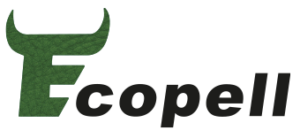Company chronicle
1982
Schomisch GmbH founded
Johann-Peter and Christel Schomisch establish the leather wholesaler Schomisch GmbH in Mülheim an der Ruhr
Relocation to Essen-Kettwig
The company moves to Essen-Kettwig
1984
1990
Relocation to a new company building
Schomisch GmbH and its 12 employees move into a modern new company building in the Kettwig industrial park. The generous storage space capacities favor the fast delivery to customers mainly from the upholstered furniture industry.
New leather under the brand name Ecopell
J.P. Schomisch realizes his idea of an industrially produced, vegetable-tanned and natural furniture leather, which at the same time meets high standards of comfort and environmental and health compatibility. The new leather is produced under the brand name Ecopell as nappa and nubuck leather in Italy.
1992
1994
New standards in product communication
Schomisch GmbH is the first company in the leather industry to publish a full declaration for its Ecopell leather, thus setting new standards in the area of product communication. Every customer can now be sure that they are informed about all substances that are in the leather.
Relocation of Ecopell production
Relocation of Ecopell production to the Möller-Werke contract tannery, Bielefeld.
October 1994
1995
Information brochure “Ecopell - leather can be so eco-comfortable”
The information brochure “Ecopell – leather can be so eco-comfortable” provides detailed information about the production process and the special properties of Ecopell leather.
Schomisch GmbH participates in a research project
Schomisch GmbH participates in a research project on the usability of native plants for the extraction of tannins. The development of rhubarb-tanned leather has started.
1996
August 1996
New in the "natural thick leather" range
The Schomisch leather range of vegetable-tanned leathers is supplemented by “thick leather, natural” and pigmented leather.
Ecopell improves the ecological balance
Schomisch GmbH replaces the vegetable tanning agent Mimosa (from monoculture cultivation in South America) with harvestable Valonea and tare tannins and thus further improves the ecological balance of the Ecopell.
February 1997
March 1997
First model preview of rhubarb-tanned leather
Together with partners from the leather processing industry, Schomisch GmbH is presenting a model preview of shoes, leather goods and furniture made from rhubarb-tanned leather for the first time. The tanning agent used comes from agricultural test areas.
BioFach trade fair 98
At the BioFach trade fair 98, Schomisch GmbH will be showing off brush-dyed leather in Ecopell quality with vegetable dyes as a world first.
February 1998
April 1998
Schomisch GmbH presents two new leather collections
Schomisch GmbH presents two new leather collections: orthopedic leather and shoe leather in Ecopell quality. Shoe upper leather is offered as a through-dyed and as a vegetable brush-dyed variant. The share of Ecopell leather in the company’s total sales has grown to 80%.
Excellent skin tolerance
A recognized testing institute certifies that Ecopell lining leather is extremely skin-friendly.
May 1998
November 1999
Approx. 8,000 square meters of leather hides
Approx. 8,000 square meters of rhubarb-tanned leather hides can be made from the first regular rhubarb harvest (this corresponds to approx. 30,000 pairs of leather shoes).
Relocation to Weitnau im Allgäu
Relocation to the new company location in Weitnau im Allgäu. The company building there was built according to ecological standards.
August 2000
January 2007
Change of name
Change of name to Ecopell GmbH.
ECARF award
Ecopell is recognized as the first allergy-friendly leather in Europe by the ECARF Institute.
January 2012
February 2012
IVN certification
The IVN – International Association of Natural Textiles certifies Ecopell as the world’s first natural leather.
BIOKREIS certification
From now on, the Ecopell leathers will be re-certified every year by the Association for Organic Farming.
July 2012




